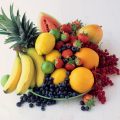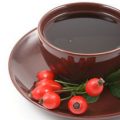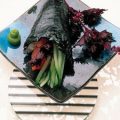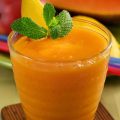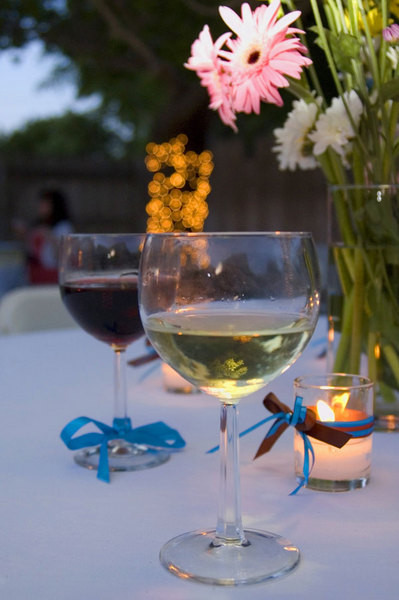 What to serve with wineThe choice of dishes is made according to the followingconsiderations. Complex tastes require simple wines, complex wines need simple dishes: the finer the wine, the simpler the food. Taste matching is the main indicator for choosing a drink for a given dish. A less aged, less valuable and expensive wine may be better, tastier, more pleasant if it matches the dish than the oldest, most precious one, if the taste of this drink, its aroma, bouquet not only does not emphasize, does not reveal the characteristic features and merits of the dish, but is in sharp discrepancy with it. An ordinary, usual wine can, together with some dish, form a flawless "taste ensemble" in its properties. The flavors of wine and food should match: it is better to serve a young wine with a bright fruity taste with sweets (dry wine with dessert will seem sour, but will go well with spicy dishes). Sequence. So, before a meal, to whet the appetite, we drink an aperitif. White table wines - with appetizers, light meat and fish dishes. Natural dry, semi-dry and semi-sweet wines go well with vegetable dishes. Red table wines go well with lamb, veal, game, poultry, shashlik, pilaf, boiled pork. Sherry or Madeira also goes well with meat or chicken broth. Liqueur, dessert wines, sweet brands of champagne are recommended for dessert - confectionery, fruits, coffee, ice cream. Champagne can also be served with a light snack - cheese, dry unleavened biscuits. Dry and semi-dry champagne can be drunk both at the beginning and during lunch, dinner, and also for dessert.
What to serve with wineThe choice of dishes is made according to the followingconsiderations. Complex tastes require simple wines, complex wines need simple dishes: the finer the wine, the simpler the food. Taste matching is the main indicator for choosing a drink for a given dish. A less aged, less valuable and expensive wine may be better, tastier, more pleasant if it matches the dish than the oldest, most precious one, if the taste of this drink, its aroma, bouquet not only does not emphasize, does not reveal the characteristic features and merits of the dish, but is in sharp discrepancy with it. An ordinary, usual wine can, together with some dish, form a flawless "taste ensemble" in its properties. The flavors of wine and food should match: it is better to serve a young wine with a bright fruity taste with sweets (dry wine with dessert will seem sour, but will go well with spicy dishes). Sequence. So, before a meal, to whet the appetite, we drink an aperitif. White table wines - with appetizers, light meat and fish dishes. Natural dry, semi-dry and semi-sweet wines go well with vegetable dishes. Red table wines go well with lamb, veal, game, poultry, shashlik, pilaf, boiled pork. Sherry or Madeira also goes well with meat or chicken broth. Liqueur, dessert wines, sweet brands of champagne are recommended for dessert - confectionery, fruits, coffee, ice cream. Champagne can also be served with a light snack - cheese, dry unleavened biscuits. Dry and semi-dry champagne can be drunk both at the beginning and during lunch, dinner, and also for dessert. For champagne served at the table outside of dinner ordinner, it is recommended to serve various cheeses, as well as dry biscuits, cakes, pastries, sweets, candies, fruits, nuts, pistachios, roasted salted almonds. A glass of strong (but not dessert) red or white vermouth is good for spicy salads, meat appetizers - cold veal, boiled tongue, cold meats, ham. Despite some sweetness inherent in this drink, its unique aroma, bitter taste, the smell of wormwood, cinchona bark and cloves harmonize well with the taste of many appetizers. Light white wines with a soft taste and subtle aroma without sharp acidity or semi-dry wine and champagne are most suitable for oysters, mussels, shrimps. Strong grape wines are recommended for first courses - Madeira, port, sherry, marsala; and for broths - sherry and Madeira. Dry white grape wines can be offered with hot fish dishes - steamed, boiled, in brine fish, with fish dishes prepared with thin, delicate sauces, with fish quenelles and with fried fish. Rieslings are especially recommended for these dishes. Dry red grape wines are recommended for second meat dishes - beefsteak, fillet, langet, entrecote, escalope, a variety of natural and breaded cutlets, schnitzel, rump steak, fried beef, lamb, pork, veal, dishes prepared from liver, kidneys, brains. Wine served at the wrong time, with the wrong dish, or at the wrong temperature, loses much of its merit. The taste of wine is spoiled by tobacco smoke, spicy culinary smells, vinegar, acidity of citrus fruits, fatty fish, vanilla, mocha coffee and cinnamon, pure chocolate (excluding only fortified wines from Muscat varieties), and also mint. For a more complete and vivid revelation of the taste of wine, it should also have the appropriate temperature.
For champagne served at the table outside of dinner ordinner, it is recommended to serve various cheeses, as well as dry biscuits, cakes, pastries, sweets, candies, fruits, nuts, pistachios, roasted salted almonds. A glass of strong (but not dessert) red or white vermouth is good for spicy salads, meat appetizers - cold veal, boiled tongue, cold meats, ham. Despite some sweetness inherent in this drink, its unique aroma, bitter taste, the smell of wormwood, cinchona bark and cloves harmonize well with the taste of many appetizers. Light white wines with a soft taste and subtle aroma without sharp acidity or semi-dry wine and champagne are most suitable for oysters, mussels, shrimps. Strong grape wines are recommended for first courses - Madeira, port, sherry, marsala; and for broths - sherry and Madeira. Dry white grape wines can be offered with hot fish dishes - steamed, boiled, in brine fish, with fish dishes prepared with thin, delicate sauces, with fish quenelles and with fried fish. Rieslings are especially recommended for these dishes. Dry red grape wines are recommended for second meat dishes - beefsteak, fillet, langet, entrecote, escalope, a variety of natural and breaded cutlets, schnitzel, rump steak, fried beef, lamb, pork, veal, dishes prepared from liver, kidneys, brains. Wine served at the wrong time, with the wrong dish, or at the wrong temperature, loses much of its merit. The taste of wine is spoiled by tobacco smoke, spicy culinary smells, vinegar, acidity of citrus fruits, fatty fish, vanilla, mocha coffee and cinnamon, pure chocolate (excluding only fortified wines from Muscat varieties), and also mint. For a more complete and vivid revelation of the taste of wine, it should also have the appropriate temperature. Dry white wines taste best when slightlychilled (to 10-12°C). In summer, these wines can be chilled to 8-10°C. They quench thirst perfectly and give coolness. Red dry wines, on the contrary, are slightly warmed. They should have a temperature slightly above room temperature, i.e. 18-20°C, in summer 16-18°C. Sherry and Madeira are warmed 4-5°C above room temperature (a glass of mulled wine after frost - what could be better?). Dessert wines, muscats, Tokaji should have room temperature (16-18°C). There is a widespread opinion that champagne tastes almost frozen. This opinion is certainly wrong, because the sharp burning sensation of cold drowns out the pleasant "sparkling" of this drink. Champagne reveals all its advantages most fully and harmoniously when cooled, but not below 6-7°C. Enjoy your meal!
Dry white wines taste best when slightlychilled (to 10-12°C). In summer, these wines can be chilled to 8-10°C. They quench thirst perfectly and give coolness. Red dry wines, on the contrary, are slightly warmed. They should have a temperature slightly above room temperature, i.e. 18-20°C, in summer 16-18°C. Sherry and Madeira are warmed 4-5°C above room temperature (a glass of mulled wine after frost - what could be better?). Dessert wines, muscats, Tokaji should have room temperature (16-18°C). There is a widespread opinion that champagne tastes almost frozen. This opinion is certainly wrong, because the sharp burning sensation of cold drowns out the pleasant "sparkling" of this drink. Champagne reveals all its advantages most fully and harmoniously when cooled, but not below 6-7°C. Enjoy your meal!

Making Money with Desserts: Success Stories
Evgeniya Polischuk (Fedutinova) instagram:@evgeniyafedutinovavk.com/janeshomebaking– It all started with baking for family and friends. Gradually, I started posting photos of my baked goods on Instagram – and orders started coming in. I made my first custom-made cake on October 13, 2014, and a little earlier I started making macaroons and cupcakes. You could say that the business “found me”, I am very […]

Soups are cold recipes with photos
Cold cucumber soup with yogurt and lemonsorbet from the chef of the restaurant La Taverna Alexander Zhurkin Photo: Getty Images Ingredients: Plain yoghurt – 125 g Cucumber – 150 g Lemon/lime sorbet – 50 g Cocktail shrimp – 24 g Fresh ginger juice – 1 g Lime juice – 5 g Fresh orange juice – 5 g Parsley – 1 g Pink pepper – 1 g Watercress – […]

barbeque kebab
Pork tenderloin in glaze Photo:Dmitry Bayrak/dbstudioPreparation time: 20 minutes + marinating time.Calories: 454 kcal per serving.For 4 servings: 4 pork tenderloins (approximately 300 g each), 1 onion, 2 cloves of garlic, 1 tsp. lemon zest, 1 tsp. lemon juice, a pinch of ground cumin, coriander and turmeric, 1 tbsp. vegetable […]

Pierre Duacan: dietary recipes: Ducane diet
Beetroot soup Photo:Season’S, Luxury Hotels RepresentationYou will need:· Boiled beetroot – 60 g· Fresh cucumbers – 20 g· Red radish – 20 g· Green onions – 10 g· Egg – 1 pc.· Drinking mineral water – 200 g· Salt – 1 gPreparation:· Boil the egg and beetroot.· Grate the cucumbers, radish and part of the beetroot. Put everything […]

